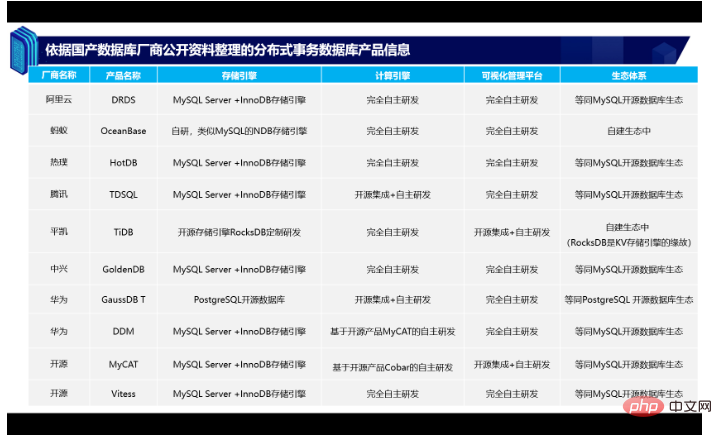What are distributed databases?
Distributed databases include: 1. In the direction of the Internet of Things, time series database products meet the collection, storage and statistics of IoT data, such as InfluxDB, Kudu, kdb, and OpenTSDB; 2. In the direction of transaction relationships, Ant Financial Oceanbase , Tencent TDSQL.

Distributed database products on the market are divided into several categories:
1. Internet of Things direction: time series database products to meet the collection of IoT data , storage and statistics. Time series database products are also the ones that have the greatest impact on memory database products. For example: InfluxDB, Kudu, kdb, OpenTSDB;
2. Transaction relationship direction: replace traditional transaction relational database products Oracle/DB2 and other online transaction businesses that cannot meet the needs of massive throughput, massive concurrency, massive transactions, and massive storage. Scenes. For example: Ant Financial Oceanbase, Tencent TDSQL, Repu HotDB, ZTE GoldenDB, open source MyCAT, open source Cobar.
3. Analysis relationship direction: solve business scenarios of structured data storage and data analysis, such as: Greenplum, Vertical, Gbase8a, etc. However, this area has received a huge impact from KV analysis products;
4. KV analysis direction: Hadoop and Spark are the current cornerstones. Many domestic and foreign companies are doing secondary research and development based on them. In particular, it is compatible with SQL standard syntax and has catered to business scenarios and R&D personnel.
5. KV document direction: solve the unstructured data storage and data processing of online document types, such as MongoDB and SequoiaDB, but they are also trying their best to be compatible with SQL standard syntax.
6. HTAP: Transaction analysis hybrid distributed database product. From the perspective of technical principles, this is a direction without theoretical innovation support. It is just the inner wish of our technical staff, such as: domestic TiDB, foreign Spanner/F1 (no one knows what it looks like or what the experience is like).
Each route will have its own specific algorithm, specific architecture and product features. It is difficult to have a product that is compatible with all and has great performance.

The above is the detailed content of What are distributed databases?. For more information, please follow other related articles on the PHP Chinese website!

Hot AI Tools

Undresser.AI Undress
AI-powered app for creating realistic nude photos

AI Clothes Remover
Online AI tool for removing clothes from photos.

Undress AI Tool
Undress images for free

Clothoff.io
AI clothes remover

AI Hentai Generator
Generate AI Hentai for free.

Hot Article

Hot Tools

Notepad++7.3.1
Easy-to-use and free code editor

SublimeText3 Chinese version
Chinese version, very easy to use

Zend Studio 13.0.1
Powerful PHP integrated development environment

Dreamweaver CS6
Visual web development tools

SublimeText3 Mac version
God-level code editing software (SublimeText3)

Hot Topics
 1369
1369
 52
52
 Comparison of distributed database management tools: MySQL vs. TiDB
Jul 12, 2023 am 11:57 AM
Comparison of distributed database management tools: MySQL vs. TiDB
Jul 12, 2023 am 11:57 AM
Comparison of distributed database management tools: MySQL vs. TiDB In today's era of growing data volume and data processing needs, distributed database management systems are increasingly widely used. MySQL and TiDB are two of the distributed database management tools that have attracted much attention. This article will conduct a comprehensive comparison between MySQL and TiDB and explore their characteristics and advantages. MySQL is an open source relational database management system that is widely used in various application scenarios. It has good stability, reliability and success
 MySql's distributed database: How to use MySQL to implement a distributed database
Jun 15, 2023 pm 06:42 PM
MySql's distributed database: How to use MySQL to implement a distributed database
Jun 15, 2023 pm 06:42 PM
With the continuous development of Internet technology, the use of databases is becoming more and more common. Whether you are a business or an individual, you need to use a database to store and manage data. For large enterprises, using one database alone can no longer meet business needs. At this time, it is necessary to use distributed databases to achieve decentralized storage and management of data. MySQL is one of the most widely used open source databases at present, so how to use MySQL to implement a distributed database? 1. What is a distributed database? A distributed database refers to a database system that is dispersed across
 How to build a highly available MySQL cluster using distributed database architecture
Aug 02, 2023 pm 04:29 PM
How to build a highly available MySQL cluster using distributed database architecture
Aug 02, 2023 pm 04:29 PM
How to use distributed database architecture to build a highly available MySQL cluster. With the development of the Internet, the demand for high availability and scalability of databases is getting higher and higher. Distributed database architecture has become one of the effective ways to solve these needs. This article will introduce how to use a distributed database architecture to build a highly available MySQL cluster and provide relevant code examples. Building a MySQL master-slave replication cluster MySQL master-slave replication is the basic high-availability solution provided by MySQL. Through master-slave replication, data can be
 Configuring Linux systems to support distributed database development
Jul 04, 2023 am 08:24 AM
Configuring Linux systems to support distributed database development
Jul 04, 2023 am 08:24 AM
Configuring Linux systems to support distributed database development Introduction: With the rapid development of the Internet, the amount of data has increased dramatically, and the requirements for database performance and scalability are also getting higher and higher. Distributed databases emerged as a solution to this challenge. This article will introduce how to configure a distributed database environment under Linux system to support distributed database development. 1. Install the Linux system First, we need to install a Linux operating system. Common Linux distributions include Ubuntu, CentOS, D
 What are the characteristics of distributed database systems?
Sep 05, 2023 pm 05:09 PM
What are the characteristics of distributed database systems?
Sep 05, 2023 pm 05:09 PM
The characteristics of distributed database systems include data consistency, concurrent access, distributed computing, load balancing, scalability, security and reliability, etc. Detailed introduction: 1. Data consistency. A distributed database system stores data through multiple servers, so the consistency of the data is jointly maintained by multiple servers. Each server can store and update data independently, but they must abide by the consistency. Constraints, such as transaction isolation level, data integrity, etc.; 2. Concurrent access, the distributed database system can support multiple users to read and write data at the same time, etc.
 MySql replication and clustering: how to implement large-scale distributed databases
Jun 16, 2023 am 08:04 AM
MySql replication and clustering: how to implement large-scale distributed databases
Jun 16, 2023 am 08:04 AM
With the development of business and the gradual increase of data volume, a single database can no longer fully meet the needs, and distributed database systems have become an important solution in the industry. MySQL is currently one of the most popular relational databases, and there are many solutions for using MySQL to build distributed databases. In this article, we will delve into MySQL replication and clustering and how to implement large-scale distributed databases. 1. MySQL’s infrastructure MySQL’s infrastructure mainly consists of three parts: Client
 Interaction between Golang functions and distributed databases in distributed systems
Apr 19, 2024 pm 03:06 PM
Interaction between Golang functions and distributed databases in distributed systems
Apr 19, 2024 pm 03:06 PM
In a distributed system, Go functions can interact with distributed databases. The specific steps are as follows: Install the necessary dependencies. Use spanner.NewClient function to connect to the database. Use the Query method to execute the query and obtain the iterator. Use the Do method to iterate through the query results and process the data. After the query is completed, use the Close method to close the connection.
 What are the implementation methods of distributed database in PHP7.0?
May 26, 2023 am 09:12 AM
What are the implementation methods of distributed database in PHP7.0?
May 26, 2023 am 09:12 AM
PHP is a scripting language widely used in web development. It has the advantages of being easy to learn and use, high efficiency, and cross-platform. As the complexity of web applications continues to increase, higher requirements are also put forward for data storage and management. It is difficult for traditional single relational databases to meet these needs, so distributed databases have become the focus of developers. In PHP7.0, there are many ways to implement distributed databases, and we will introduce them one by one below. Table splitting is a common distributed database implementation method, which splits a large table into




